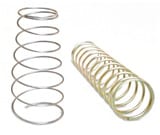There are many types of compression springs on the market. Each is designed with distinct characteristics to meet the many different kinds of functional requirements of mechanical assemblies in which they are applied. Though a particular application may require a compressive force, the type of compression spring can affect how the spring interacts and performs within a specific mechanism. The choice of compression spring type then, is driven by the application requirements of the device and will depend on a number of variables such as the space constraints, the desired load distribution and capacity, the type of components being mated, the spring rate, and related performance characteristics.
 Compression springs are by far the most common type of spring found in mechanical assemblies. They are recognized by their cylindrical, open coil, helical shape. Unlike other spring designs, the coils of a compression spring do not touch. They store and release energy when a compressive force or load is applied and, when removed, returns to its original length. Generally installed in slots or on shafts, and sometimes both, compression springs are used in various applications across different industries. There are several popular types of compression springs, each designed for specific purposes. Here are some of the more common types:
Compression springs are by far the most common type of spring found in mechanical assemblies. They are recognized by their cylindrical, open coil, helical shape. Unlike other spring designs, the coils of a compression spring do not touch. They store and release energy when a compressive force or load is applied and, when removed, returns to its original length. Generally installed in slots or on shafts, and sometimes both, compression springs are used in various applications across different industries. There are several popular types of compression springs, each designed for specific purposes. Here are some of the more common types:
Closed-End Coiled
In a closed-end design, the last coil on either end of the spring is closed and tightly wound, touching the adjacent coil. This design is intended to provide a flat surface for the spring end to be seated firmly against supporting components. As the ends are squared off, this type of compression spring ensures stability, proper alignment and load distribution within the assembly.
Open-End Coiled
By definition, the ends of the open-end type of compression spring are left open, meaning, they are not squared off like a closed-end compression spring. Open-ended designs are generally used in applications where the spring can be inserted within a slot, mounted on a shaft or rod.
Conical Compression Springs
A conical-shaped compression spring’s shape results from the decrease in the coil diameter from one end of the spring to the other. In other words, one end of the spring has a smaller diameter than the other. When compressed, the conical spring is at an almost solid height. Conical compression springs, also referred to as tapered springs, provide a variable spring rate and are designed to accommodate uneven or non-linear loads.
Hourglass (Concave) Compression Springs
As the name suggests, hourglass compression springs have a tapered design with a smaller diameter at the center. This shape allows them to provide a progressive or variable spring rate, making them suitable for applications where a soft initial compression is needed, followed by increased resistance.
Barrel (Convex) Compression Springs
The barrel-shaped compression spring is easily identified by the larger diameter at the center in contrast to the ends. The barrel-shaped design of the spring is used to carry a higher load capacity in a limited space.
Variable Pitch Compression Springs
These types of compression springs have varying coil spacing along their length. This design allows for a progressive or variable spring rate, making them suitable for applications with changing load requirements.
Miniature Compression Springs
These are very small compression springs designed for use in compact devices or applications with limited space, such as cell phones. They come in various shapes and sizes to meet specific requirements.
Wire Diameter-Variable Compression Springs
In these springs, the wire diameter varies along the length of the coil. This design provides a controlled change in stiffness, i.e., the spring rate.
The choice of compression spring type depends on a number of important factors, such as load, deflection, space constraints, and desired spring characteristics. At James Spring and Wire Company, our engineers and designers can help you select the appropriate type of compression spring to ensure that the spring performs as intended to function effectively and reliably. We offer custom compression spring designs made from a wide range of materials, to your specifications, no matter the application requirements. Contact us today to discuss a custom solution that meets your needs.

